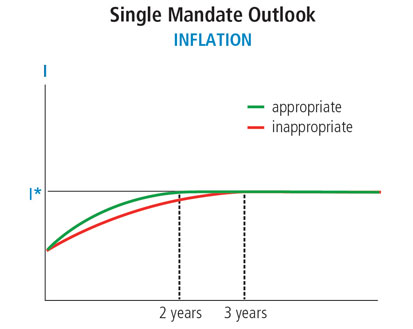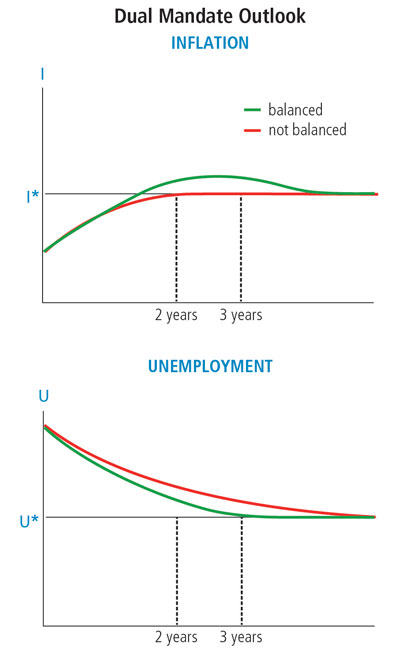Disclaimer*
Editor’s note: This column is based on remarks presented at the 57th Economic Conference of the Federal Reserve Bank of Boston in Boston, Mass., on April 13, 2013.
The media pay a great deal of attention to Federal Open Market Committee deliberations and decisions. This scrutiny tends to focus on the differences among Committee participants’ views on appropriate monetary policy. Too often lost in this media conversation are the elements of monetary policy that FOMC participants whole-heartedly share. One such common element is the goal of monetary policy: our dual mandate.
Making monetary policy is, of course, the primary reason we come together regularly at FOMC meetings. More specifically, we aim—in concert—to formulate policy to achieve our congressionally mandated objectives of promoting price stability and promoting maximum employment.
Beyond those high-level objectives, the Committee has established common principles that underlie its long-run goals and strategies. These principles, expressed in just five paragraphs, are described in a document released last year.1 All of these principles enjoyed broad FOMC support from participants when the statement was first adopted in January 2012, and they have since been reaffirmed, in January 2013.
I believe that anyone interested in U.S. monetary policy should read this statement. In part, the statement matters because of its substance. But it also matters because so many FOMC participants approved the document. These truly are our common principles in pursuit of our dual mandate.
One piece of this document that has received a lot of attention—and quite rightly so—is that it establishes a longer-run goal for inflation of 2 percent per year. I believe that this numerical target has served and will continue to serve the Committee well in keeping inflation expectations anchored.
In this note, I’ll discuss my views on how we as policymakers should seek to achieve, or operationalize, these commonly held FOMC principles. And in particular, I’ll focus on the last paragraph in the statement, which I view as its most operational. That paragraph is duplicated below:
Final paragraph of FOMC principles statement
In setting monetary policy, the Committee seeks to mitigate deviations of inflation from its longer-run goal and deviations of employment from the Committee’s assessments of its maximum level. These objectives are generally complementary. However, under circumstances in which the Committee judges that the objectives are not complementary, it follows a balanced approach in promoting them, taking into account the magnitude of the deviations and the potentially different time horizons over which employment and inflation are projected to return to levels judged consistent with its mandate.
Setting policy if the Fed had a single mandate
I’ll start this discussion by focusing on part of that paragraph’s first sentence: “The Committee seeks to mitigate deviations of inflation from its longer-run goal...” (emphasis added).
For the sake of discussion, I’d like to pretend, initially, that the Federal Reserve is a central bank with a single mandate: promoting price stability. If that actually were the case—if the Fed had only the one mandate of promoting price stability—then I think this sentence would be an adequate description of the FOMC’s longer-run strategy. That is, to promote price stability we would seek to mitigate all deviations of inflation from our long-run target of 2 percent.
So, if that were an accurate description of the Committee’s long-run strategy under a single mandate, how could it distinguish between appropriate and inappropriate policies?
The chart below is very helpful along these lines. It depicts the evolution of inflation under two very distinct monetary policy stances. According to one position for monetary policy, the outlook for the future is described by the red line, the one I’ve labeled here as “inappropriate.” Under the other policy stance, the outlook is described by the green line, labeled “appropriate.”
Why have I chosen those terms—appropriate and inappropriate—to describe different stances for achieving the (hypothetical) single mandate? Let’s look at the red line first, and consider the monetary policy stance that gives rise to it. Under that policy, the inflation rate returns to its desired level (shown here as a black horizontal line and labeled I*on the y-axis) within three years.
The I* here is a rather abstract description of the desired inflation rate, but as I mentioned earlier, the FOMC’s principles statement establishes a desired long-term rate of 2 percent per year. So, under the red policy stance, we’re returning to that long-run target three years after the policy is put into operation.
Given the time lag inherent in implementing monetary policy, we generally think of policy as being effective if it achieves its goal(s) in one to two years. Therefore, a policy that takes a full three years is relatively ineffective, and is thus an “inappropriate” choice.
A better choice under a single mandate
What would be a more appropriate policy decision in this single-mandate scenario? By increasing monetary accommodation—that is, lowering interest rates—we could get back to target more rapidly, within the one- to two-year time frame. That’s shown in the chart with the green line. Under this policy stance, inflation returns to its long-run goal of I*—or less abstractly, 2 percent annually—within two years.
Therefore, with this policy stance—a higher level of monetary accommodation—the Committee is doing a more effective job of mitigating deviations of inflation from its long-run objective. Why “more effective”? At any point in time, the outlook for inflation under this second monetary policy stance, as shown by the green line, is closer to the long-run target of I* than it would be under the policy stance that results in the red line—except, of course, after three years when both policy stances have achieved the same inflation rate level.
So, this kind of outlook chart helps sort out what kinds of policy stances are appropriate and inappropriate. In particular, the chart clarifies that the red stance is inappropriate because policymakers could more quickly “mitigate deviations of inflation from its longer-run goal” by increasing monetary accommodation.
Now, I want to emphasize again that this entire discussion was under the deliberate pretense that the Fed has only a single mandate. Of course, Congress has actually given the Fed a dual mandate. I’ll turn to that more realistic scenario now.
Setting policy under a balanced, dual mandate
The FOMC principles statement is very alive to the fact that the Fed has a responsibility to meet a dual mandate. The final paragraph says “the Committee seeks to mitigate deviations of inflation from its longer-run goal and deviations of employment from the Committee’s assessments of its maximum level” (emphasis added).
Now, generally, as the principles statement says, these are “complementary” objectives. That means that policies that lead inflation back to 2 percent within two years will also lead employment to return to its maximum level within that same time frame. Achieving one objective is consistent with achieving the other.
But I’d like to address a more interesting case, in which these objectives are not complementary. What should policymakers do in that case, when achieving one of the mandates—maximum employment, say—appears to conflict with the other—achieving price stability? Well, the Committee’s principles statement clearly states that “it follows a balanced approach” to the mitigation of deviations of inflation and the deviations of employment. What does “a balanced approach” mean?
The statement leaves room for judgment among policymakers along that dimension. One thing it certainly does mean, I think, is that we’re putting weight on both mandates. We’re not focusing exclusively on maximum employment, or entirely on price stability. Rather, we’re looking at both mandates in making decisions about the appropriate policy stance.
Given this language of the Committee’s strategy—that it will follow a balanced approach in promoting the employment and price stability mandates if it judges them not to be complementary—how do we distinguish between policy stances that are appropriate and those that aren’t? Again, I think economic outlook charts similar to the one just discussed are very informative.
Balancing mandates
Below are two such charts. The first describes the evolution of inflation, the other shows the outlook over time for unemployment. And each of these charts looks at evolution under two distinct monetary policy stances, a stance that corresponds to the red outlooks and another corresponding to the green outlooks.
Let me begin with the red outlook, for both the inflation and employment charts. Under that monetary policy stance, inflation is returning to its long-run objective within two years. If the Fed had only a single mandate, we would judge that policy stance to be “appropriate” because inflation is getting back to the desired target within a two-year time frame.
But in reality, we have two mandates, maximum employment as well as price stability. The second chart considers a metric corresponding to the employment mandate—the usual metric we use is the unemployment rate. Here the chart indicates a desired unemployment rate level, consistent with maximum employment, by a black horizontal line and a U* on the y-axis (similar to the inflation target in the inflation chart.)
We see that under the red outlook, the unemployment rate approaches its desired level at some time well beyond three years. This monetary policy, the red stance, is therefore not balanced in its approach to the two mandates. It’s focusing exclusively on price stability and mitigating deviations of inflation from its longer-run goal, but it doesn’t pay equal attention to mitigating deviations from the unemployment goal.
A balanced approach, in contrast, would be willing to concede a bit on the price stability mandate in order to get a faster return of unemployment to its desired level.
That approach is what the green outlook indicates in these charts. By adding accommodation relative to the policy stance that generates the red outlook, policymakers are able to return unemployment more quickly to its longer-run objective.
There is a cost associated with that: The higher level of accommodation pushes inflation above its desired level for a time. But that, of course, is what “balanced” means. You’re willing to ease up slightly on achieving the mandate of price stability in return for a faster return of unemployment to what’s assessed as consistent with maximum employment.
How big is this gap in the upper chart between target inflation and the highest point of the green curve? In other words, what is the cost in inflation of a balanced approach?
Deciding what that gap or cost should be is up to policymakers’ judgment. But it’s crucial to understand that there should be a gap. If there is no gap, then policymakers are not using a balanced approach to the two mandates. The gap indicates a degree of compromise that policymakers must make by deviating from one mandate to more quickly achieve the other.
Clarity for the FOMC and the public
In this essay, I’ve described a central part of the FOMC’s principles statement, which outlines its long-run goals and strategies. I’ve suggested that the statement provides a great deal of clarity about how to assess what kinds of monetary policy stances are appropriate and inappropriate under our dual mandate. This clarity should serve the Committee in its deliberations. And it should serve the public as well, as it seeks to understand the reasons underlying Committee actions.
Endnote
1 See the press release.
Disclaimer
* The views expressed here are not necessarily those of others in the Federal Reserve System, including the other participants in Federal Open Market Committee meetings.
Related Content
Related Content







